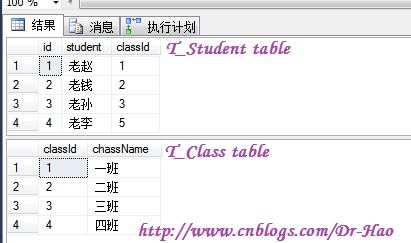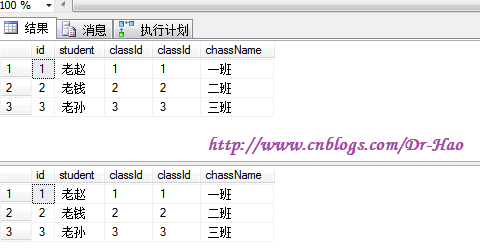MSSQL 详解SQL Server连接(内连接、外连接、交叉连接)
在查询多个表时,我们经常会用“连接查询”。连接是关系数据库模型的主要特点,也是它区别于其它类型数据库管理系统的一个标志。
什么是连接查询呢?
概念:根据两个表或多个表的列之间的关系,从这些表中查询数据。
目的:实现多个表查询操作。
知道了连接查询的概念之后,什么时候用连接查询呢?
一般是用作关联两张或两张以上的数据表时用的。看起来有点抽象,我们举个例子,做两张表:学生表(T_student)和班级表(T_class)
--创建DB
--filename修改为自己电脑上MSSQL存储的位置
create database MyTestDB
on primary
(
name='MyTestDB',
filename='D:\yangZ_MSSQL\MyTestDB.mdf',
size=10mb,
maxsize=100mb,
filegrowth=10%
)
log on
(
name='MyTestDB_log',
filename='D:\yangZ_MSSQL\MyTestDB_log.ldf',
size=2mb,
maxsize=100mb,
filegrowth=5mb
)
---------------------------------------------
use MyTestDB
go create table T_Student
(
id int identity(1,1) primary key,
student nvarchar(100) not null,
classId int not null
) create table T_Class
(
classId int identity(1,1) primary key,
chassName nvarchar(100) not null
)
-------------------------------------------
---设置T_Student classId字段为外键
alter table T_Student add constraint FK_T_Student_classId foreign key(classId) references T_Class(classId)
-- 增加外键约束时,设置【级联更新、级联删除】:来保证,当主键表中的记录发生改变时候,对应的外键表中的数据也发生相应的改变。
on delete cascade
on update cascade ---删除外键
alter table T_Student drop constraint FK_T_Student_classId -------------------------------------------
insert into T_Class
select '一班' union all
select '二班' union all
select '三班' union all
select '四班'
go insert into T_Student
select '老赵',1 union all
select '老钱',2 union all
select '老孙',3 union all
select '老李',5
go
-------------------------------------------
select * from T_Student
select * from T_Class
MSSQL create DB and Table(T_Student/T_Class)

连接标准语法格式:
SQL-92标准所定义的FROM子句的连接语法格式为:
FROM join_table join_type join_table[ON (join_condition)]
其中join_table指出参与连接操作的表名,连接可以对同一个表操作,也可以对多表操作,对同一个表操作的连接又称做自连接。join_type 指出连接类型。join_condition指连接条件。
连接类型:
连接分为三种:内连接(INNER JOIN)、外连接、交叉连接(CROSS JOIN)[也称迪卡尔积]。
内连接: 等值连接、不等连接、自然连接
外连接: 左连接(LEFT JOIN/LEFT OUTER JOIN)、右连接(RIGHT JOIN/RIGHT OUTER JOIN)和全连接(FULL JOIN/FULL OUTER JOIN)
交叉连接: 不带where、有where子句
内连接(INNER JOIN)
使用比较运算符(包括=、>、<、<>、>=、<=、!>和!<)进行表间的比较操作,查询与连接条件相匹配的数据。根据比较运算符不同,内连接分为等值连接、自然连接和不等连接三种。
1、等值连接
概念:在连接条件中使用等于号(=)运算符,其查询结果中列出被连接表中的所有列,包括其中的重复列。
select * from T_Student as s,T_Class as c
where s.classId = c.classId
--等价于下面的写法
select * from T_student s inner join T_class c on s.classId = c.classId
MSSQL查询结果为:

2、不等连接
概念:在连接条件中使用除等于号之外运算符(>、<、<>、>=、<=、!>和!<)
select * from T_Student as s, T_Class as c
where s.classId <> c.classId
--等价于下面的写法
select * from T_Student s inner join T_Class c on s.classId <> c.classId
MSSQL查询结果为:

3、自然连接
概念:连接条件和等值连接相同,但是会删除连接表中的重复列。
查询语句同等值连接基本相同:
select s.*,c.chassName from T_student s inner join T_class c on s.classId = c.classId
MSSQL查询结果为:

总结:内连接是只显示满足条件的!
外连接
外连接分为左连接(LEFT JOIN)或左外连接(LEFT OUTER JOIN)、右连接(RIGHT JOIN)或右外连接(RIGHT OUTER JOIN)、全连接(FULL JOIN)或全外连接(FULL OUTER JOIN)。我们就简单的叫:左连接、右连接和全连接。
1、左连接:
概念:返回左表中的所有行,如果左表中行在右表中没有匹配行,则结果中右表中的列返回空值。
select * from T_student s left join T_class c on s.classId = c.classId
MSSQL查询结果为:

总结:左连接显示左表全部行,和右表与左表相同行。
2、右连接:
概念:恰与左连接相反,返回右表中的所有行,如果右表中行在左表中没有匹配行,则结果中左表中的列返回空值
select * from T_student s right join T_class c on s.classId = c.classId
MSSQL查询结果为:

总结:右连接恰与左连接相反,显示右表全部行,和左表与右表相同行。
3、全连接:
概念:返回左表和右表中的所有行。当某行在另一表中没有匹配行,则另一表中的列返回空值
select * from T_student s full join T_class c on s.classId = c.classId
MSSQL查询结果为:

总结:返回左表和右表中的所有行。
交叉连接(CROSS JOIN):也称迪卡尔积
概念:不带WHERE条件子句,它将会返回被连接的两个表的笛卡尔积,返回结果的行数等于两个表行数的乘积(例如:T_student和T_class,返回4*4=16条记录),
如果带where,返回或显示的是匹配的行数。
1、不带where:
select *from T_student cross join T_class
--等于
select *from T_student, T_class
MSSQL查询结果为:

总结:相当与笛卡尔积,左表和右表组合。
2、有where子句,往往会先生成两个表行数乘积的数据表,然后才根据where条件从中选择。
select * from T_student s cross join T_class c where s.classId = c.classId
--(注:cross join后加条件只能用where,不能用on)
MSSQL查询结果为:

查询结果跟等值连接的查询结果是一样。
MSSQL全部源码参考:
--创建DB
--filename修改为自己电脑上MSSQL存储的位置
create database MyTestDB
on primary
(
name='MyTestDB',
filename='D:\yangZ_MSSQL\MyTestDB.mdf',
size=10mb,
maxsize=100mb,
filegrowth=10%
)
log on
(
name='MyTestDB_log',
filename='D:\yangZ_MSSQL\MyTestDB_log.ldf',
size=2mb,
maxsize=100mb,
filegrowth=5mb
)
---------------------------------------------
use MyTestDB
go create table T_Student
(
id int identity(1,1) primary key,
student nvarchar(100) not null,
classId int not null
) create table T_Class
(
classId int identity(1,1) primary key,
chassName nvarchar(100) not null
)
-------------------------------------------
---设置T_Student classId字段为外键
alter table T_Student add constraint FK_T_Student_classId foreign key(classId) references T_Class(classId)
-- 增加外键约束时,设置【级联更新、级联删除】:来保证,当主键表中的记录发生改变时候,对应的外键表中的数据也发生相应的改变。
on delete cascade
on update cascade ---删除外键
alter table T_Student drop constraint FK_T_Student_classId -------------------------------------------
insert into T_Class
select '一班' union all
select '二班' union all
select '三班' union all
select '四班'
go insert into T_Student
select '老赵',1 union all
select '老钱',2 union all
select '老孙',3 union all
select '老李',5
go
-------------------------------------------
select * from T_Student
select * from T_Class
-------------------------------------------
--1、等值连接
--概念:在连接条件中使用等于号(=)运算符,其查询结果中列出被连接表中的所有列,包括其中的重复列。
select * from T_Student as s,T_Class as c
where s.classId = c.classId
--等价于下面的写法
select * from T_student s inner join T_class c on s.classId = c.classId
-------------------------------------------
--2、不等连接
--概念:在连接条件中使用除等于号之外运算符(>、<、<>、>=、<=、!>和!<)
select * from T_Student as s, T_Class as c
where s.classId <> c.classId
--等价于下面的写法
select * from T_Student s inner join T_Class c on s.classId <> c.classId
-------------------------------------------
--3、自然连接
--概念:连接条件和等值连接相同,但是会删除连接表中的重复列。
--查询语句同等值连接基本相同:
select s.*,c.chassName from T_student s inner join T_class c on s.classId = c.classId ------------------------------------------
--1、左连接:
--概念:返回左表中的所有行,如果左表中行在右表中没有匹配行,则结果中右表中的列返回空值。
select * from T_student s left join T_class c on s.classId = c.classId
------------------------------------------
--2、右连接:
--概念:恰与左连接相反,返回右表中的所有行,如果右表中行在左表中没有匹配行,则结果中左表中的列返回空值
select * from T_student s right join T_class c on s.classId = c.classId
------------------------------------------
--3、全连接:
--概念:返回左表和右表中的所有行。当某行在另一表中没有匹配行,则另一表中的列返回空值
select * from T_student s full join T_class c on s.classId = c.classId
-------------------------------------------
--交叉连接(CROSS JOIN):也称迪卡尔积
--1、不带where:
select *from T_student cross join T_class
--等于
select *from T_student, T_class
-------------------------------------------
--2、有where子句,往往会先生成两个表行数乘积的数据表,然后才根据where条件从中选择。
select * from T_student s cross join T_class c where s.classId = c.classId
--(注:cross join后加条件只能用where,不能用on)
MSSQL全部源码
MSSQL 详解SQL Server连接(内连接、外连接、交叉连接)的更多相关文章
- 详解SQL Server连接(内连接、外连接、交叉连接)
在查询多个表时,我们经常会用“连接查询”.连接是关系数据库模型的主要特点,也是它区别于其它类型数据库管理系统的一个标志. 什么是连接查询呢? 概念:根据两个表或多个表的列之间的关系,从这些表中查询数据 ...
- 详解SQL Server 2005 Express下的事件探查器
安装Visual Studio 2008会有附带的SQL Server 2005 Express版 我们开发一般都用那个都不单独安装SQL Server的 大家都知道express版的sql是没有 事 ...
- SQL查询优化:详解SQL Server非聚集索引(转载)
本文是转载,原文地址 http://tech.it168.com/a2011/1228/1295/000001295176.shtml 在SQL SERVER中,非聚集索引其实可以看作是一个含有聚集索 ...
- 详解SQL Server 2008工具SQL Server Profiler
一.SQL Profiler工具简介 SQL Profiler是一个图形界面和一组系统存储过程,其作用如下: 1.图形化监视SQL Server查询: 2.在后台收集查询信息: 3.分析性能: 4.诊 ...
- Exec msdb.dbo.sp_send_dbmail 参数详解(SQL Server 存储过程发邮件)
转载oriency755 发布于2012-12-04 11:34:45 阅读数 6870 收藏 sp_send_dbmail [ [ @profile_name = ] 'profile_name ...
- 详解SQL Server数据修复命令DBCC的使用
严重级别为 21 表示可能存在数据损坏. 可能的原因包括损坏的页链.损坏的 IAM 或该对象的 sys.objects目录视图中存在无效条目. 这些错误通常由硬件或磁盘设备驱动程序故障而引起. MS ...
- SQL Server中内连接和外连接的区别
SQL Server中内连接和外连接的区别 假设一个数据库中有两张表,一张是学生表StudentInfo,一张是班级表ClassInfo,两张表之间用ClassId字段进行关联. 如果用内连接,正常的 ...
- Sql Server系列:多表连接查询
连接查询是关系数据中最主要的查询,包括内连接.外连接等.通过连接运算符可以实现多个表查询.内连接查询操作列出与连接条件匹配的数据行,它使用比较运算符比较被连接列的列值.SQL Server中的内连接有 ...
- SQL Server 2005 不允许远程连接解决方法
刚刚安装的数据库系统,按照默认安装的话,很可能在进行远程连接时报错,通常是错误:“在连接到 SQL Server 2005 时,在默认的设 置下 SQL Server 不允许进行远程连接可能会导致此失 ...
随机推荐
- xpath的学习
xpath的作用就是两个字“定位”,运用各种方法进行快速准确的定位,推荐两个非常有用的的firefox工具:firebug和xpath checker 定位 1.依靠自己属性,文本定位 //td[ ...
- PHP上传文件限制的大小
修改PHP上传文件大小限制的方法 1. 一般的文件上传,除非文件很小.就像一个5M的文件,很可能要超过一分钟才能上传完.但在php中,默认的该页最久执行时间为 30 秒.就是说超过30秒,该脚本就停止 ...
- js中如何获取页面的Url,域名和端口号
有时候通过获取上个页面的Url来做一个跳转,获取域名防止非正常访问 获取上一个页面的一个URL,这个URL一般做一个页面的跳转 window.location.href <script>w ...
- 转--- 秒杀多线程第六篇 经典线程同步 事件Event
阅读本篇之前推荐阅读以下姊妹篇: <秒杀多线程第四篇 一个经典的多线程同步问题> <秒杀多线程第五篇 经典线程同步关键段CS> 上一篇中使用关键段来解决经典的多线程同步互斥问题 ...
- 转:机器学习 规则化和模型选择(Regularization and model selection)
规则化和模型选择(Regularization and model selection) 转:http://www.cnblogs.com/jerrylead/archive/2011/03/27/1 ...
- [AT2377] [agc014_e] Blue and Red Tree
题目链接 AtCoder:https://agc014.contest.atcoder.jp/tasks/agc014_e 洛谷:https://www.luogu.org/problemnew/sh ...
- byte数组转float实现与byte转换其它类型时进行&运算原理
下面是将byte数组转换为float的实现 public static float getFloat(byte[] b) { int accum = 0; accum = accum|(b[0] &a ...
- Docker学习笔记二:Docker常用命令及提升拉取镜像的速度
一.Docker命令: 1.docker images //命令用来查看docker中所包含的镜像信息 2.docker ps -a //命令用来查看docker中所包含所有容器信息(运行状 ...
- 洛谷 P2056 [ZJOI2007]捉迷藏 解题报告
P2056 [ZJOI2007]捉迷藏 题目描述 Jiajia和Wind是一对恩爱的夫妻,并且他们有很多孩子.某天,Jiajia.Wind和孩子们决定在家里玩捉迷藏游戏.他们的家很大且构造很奇特,由\ ...
- 解题:AHOI 2005 航线规划
题面 这种不断删边的首先肯定想到时光倒流啊=.= 在最后剩下的连通图上跑出一棵搜索树,先将边权都赋为$1$,那么两点间的关键航线就是链上边权和,而每加入一条非树边$u,v$都会使得$u,v$链上的边的 ...
